The Cloisters
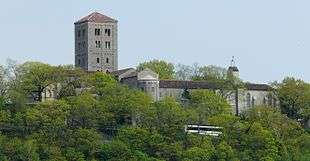 View from the Hudson River with bell tower | |
 Location within New York City | |
| Established | May 10, 1938 |
|---|---|
| Location |
99 Margaret Corbin Drive, Fort Tryon Park Manhattan, New York City |
| Coordinates | 40°51′53″N 73°55′55″W / 40.8648°N 73.9319°WCoordinates: 40°51′53″N 73°55′55″W / 40.8648°N 73.9319°W |
| Type | Medieval art |
| Collection size | 1,854 |
| Public transit access |
Bus: M4 to museum's entrance (rush hours only), or M4 or M98 (rush hours only) to the entrance of Fort Tryon Park Subway: 190th Street ( |
| Website | http://www.metmuseum.org/cloisters |
The Cloisters is a museum in Upper Manhattan, New York City specializing in European medieval architecture, sculpture and decorative arts. Its early collection was built by the American sculptor, art dealer and collector George Grey Barnard, and acquired by John D. Rockefeller, Jr. in 1925.[1] Rockefeller extended the collection and in 1931 purchased land at Washington Heights and contracted the design for a new building that was to become the Cloisters. The museum is today part of the Metropolitan Museum of Art and has been described as the "crowning achievement of American museology."[2]
Its architectural and artistic works are largely from the Romanesque and Gothic stylistic periods. Its four cloisters; the Cuxa, Bonnefont, Trie and Saint-Guilhem cloisters, were sourced from French monasteries and abbeys. Between 1934 and 1939 they were excavated and reconstructed in Washington Heights, in a large project overseen by the architect Charles Collens. They are surrounded by a series of indoor chapels and rooms grouped by period which include the Romanesque, Fuentidueña, Unicorn, Spanish and Gothic rooms.[3] The design, layout and ambiance of the building is intended to evoke in visitors a sense of the Medieval European monastic life through its distinctive architecture.[4] The area around the buildings contains a number of reconstructed early medieval gardens.
The Cloisters is a well-known New York City landmark and has been used as a filming location. In 1948, the filmmaker Maya Deren used its ramparts as a backdrop for her experimental film Meditation on Violence.[5] In the same year, German director William Dieterle used the Cloisters as the location for a convent school in his film Portrait of Jennie. The 1968 film Coogan's Bluff used the site for the scene of a shoot-out.[5]
History

The design for the 66.5-acre (26.9 ha) Fort Tryon Park was commissioned by the philanthropist John D. Rockefeller, Jr. beginning in 1917, when he purchased the Billings Estate and other properties in the Fort Washington area and hired Frederick Law Olmsted Jr., son of one of the designers of Central Park, and the Olmsted Brothers firm to create a park, which he donated to New York City in 1935. As part of the project, Rockefeller also purchased the medieval art collection of George Grey Barnard, an American sculptor and collector, who had already established a medieval-art museum near his home in Fort Washington, which he sold to the Metropolitan during one of his frequent financial crises.[6] Barnard's collection was acquired with a number of pieces from Rockefeller's own holdings, including the Unicorn Tapestries. These became the foundation and core of the Cloisters collection.
The Cloisters and the adjacent 4 acres (1.6 ha) gardens are situated in Fort Tryon Park, and were constructed with grants and endowments from Rockefeller. Construction took place over a five-year period beginning in 1934.[7][8] He also bought several hundred acres of the New Jersey Palisades, which he later donated to the State of New Jersey, to help preserve the view from the museum. This land is now part of the Palisades Interstate Park.
The Cloisters building in Washington Heights was designed by Charles Collens, and incorporated elements from the five cloistered abbeys of Catalan, Occitan and French origins. Parts from Saint-Michel-de-Cuxa, Saint-Guilhem-le-Désert, Bonnefont-en-Comminges, Trie-sur-Baïse, and Froville were disassembled stone-by-stone and shipped to New York City, where they were reconstructed and integrated into a cohesive whole. In 1988, the Treasury Gallery within the Cloisters, containing objects used for liturgical celebrations, personal devotions, and secular uses, was renovated. Other galleries were refurbished in 1999.
Chapels and halls
Fuentidueña Chapel
The Fuentidueña hall is the museum's largest room.[9] It opens with oak doors flanked by sculptures of leaping animals. It is built around the Fuentidueña Apse, a semicircular Romanesque apse dated c. 1175–1200, from the San Martín church at Fuentidueña, Segovia. The room contains a hanging crucifix and frescos honoring the Virgin Mary.[10] The chapel consists of a rectangular courtyard with covered walk ways, and beds of flowering shrubs and plants.[11] The capitals supporting the arch portray the Adoration of the Magi and Daniel in the lions' den. Its piers contain the figures of Saint Martin of Tours on the left, and the angel Gabriel announcing to The Virgin on the right. The Fuentidueña room includes a number of other, mostly contemporary medieval art works set within the Fuentidueña Apse. They include, in its dome, a large fresco painted on wet plaster c. 1130-50, from the Spanish Church of San Juan de Tredos, which in its colorization resembling a Byzantine mosaic and is dedicated to Mary.[12] Hanging within the apse is a c. 1150-1200 Crucifix from the convent of St Clara at Astudillo.
By the 19th century the church was long abandoned and in disrepair. In the late 1940s the apse was moved and reconstructed in The Cloisters, a transfer than involved the shipping of almost 300 blocks of stone from Spain to New York. The acquisition followed three decades of complex negotiation and diplomacy between the Spanish church and both countries art historical hierarchies and governments. It was eventually exchanged in a deal that involved the transfer of six frescoes from San Baudelio de Berlanga to the Prado, on an equally long term loan.[13]
Langon Chapel
The Lagon Chapel is entered from the Romanesque hall via a massive Gothic oak doorway with elaborate architectural framing. It was sourced from Moutiers-Saint-Jean in Burgundy, France. Carvings on the elaborate white oolitic limestone doorway depict the Coronation of the Virgin, and contains foliated capitals, statuettes on the outer piers, two kings positioned in the embrasures, and various kneeling angels. Carvings of angels hover in the archivolts above the kings.[14] [15]
The chapel is from the Cathédrale Notre-Dame-du-Bourg de Digne in Lagon, and dates from c. 1126.[16] The Pontault Chapter house consists of a single aisle nave, projecting transepts[17] is taken from a small parish Benedictine church of c. 1115 from Notre Dame de Pontault,[18] then in neglect and disrepair - when acquired its upper level was a storage place for tobacco. About three quarters of its original stonework was relocated to New York.[17]
The heads on the right hand capital were for a time assumed to represent Henry II of England.[19] Seven capitals survive from the original church, with carvings of human heads or figures, some now conformed as identifiable as historical persons, including of Eleanor of Aquitaine.[17]
Gothic Chapel
The Gothic chapel faces northeast and consists of two stories overlooked by stained glass windows. It is entered at ground level via a heavy abbey door at its east wall. The hall begins with a pointed Gothic arch, leading to high bayed ceilings, ribbed vaults, with buttress on the thick walled exterior.[20] The apse contains a large limestone sculpture of Saint Margaret dated to c. 1330 and from Lleida, Spain. The glass windows are of the 14th century with a depiction of Saint Martin and complex medallion patterns, the three center windows are from the church of Saint Leonhard, in southern Austria, from c. 1340.[20] The glass on the east wall comes from the abbey of Evron, Normandy, and dates from around 1325.[21]
The Gothic chapel contains four tombs, each a supreme example of sepulchral art,[22] and all from the Urgel family of Catalonia. They were built for counts, their wives and children, each with a commemorative tombstone sculptural effigy.[21] The family is associated with the church of Santa Maria at Castello de Farfanya, which was redesigned in the Gothic style by Ermengol X, who was dead by 1314.[22] The tombs are thought to contain Ermengol VI (d. 1184), who commissioned some of them. The female effigy was sourced in Normandy, dates to the mid 13th c, and is perhaps of Margaret of Gloucester.[23] Although resting on a modern base,[24] she is dressed in the height of contemporary aristocratic fashion, including a cotte, jewel studded belt and mantle, and an elaborate ring necklace brooch.[25]
Three of the tombs are from the Bellpuig de las Avellanes monastery, in northern Spain. The effigy of a young boy is from the church of Santa Maria at Casttello de Farfanya.[22]
Romanesque hall
The Romanesque hall is noted for its three great church doorways. The monumental arched Burgundian entrance is from Moutier-Saint-Jean de Réôme, France, and dated to c. 1150.[26] Two animals are carved into the keystones, both on their hind legs as if about to attack each other. The capitals are lined with carvings of both real and imagined animals and birds, as well as leaves and other fauna.[27] The two other, earlier doorways are from Reugny, Indre-et-Loire and Poitou in central France.[4] The hall contains four large early 13th-century stone sculptures representing the Adoration of the Magi, and frescoes of a lion and a wyvern, each from the Monastery of San Pedro de Arlanza, in north central Spain.[26] On the left of the room are portraits of kings and angles, also from the monastery at Moutier-Saint-Jean.[27]
The hall contains the remnants of a church at the small Augustinian church at Reugny, consisting of three pairs of columns over a door with molded archivolts.[28] Surviving records indicate that an upper "new cloisters" were installed at Saint-Guilhem-le-Désert before 1206. The site at Reugny was badly damage during both the French Wars of Religion and French Revolution, and most of it had already been sold on by 1850 by Piere-Yon Verniere, whose heir sold it on to Barnard in 1906.[29]
Cloisters
The museum contains architecture elements and settings relocated from four French medieval abbeys: the Cuxa, Bonnefort, Trie and Saint-Guilhem cloisters. Between 1934 and 1939 they were transported, reconstructed and integrated with new buildings, in projects overseen by the architect Charles Collens.
Cuxa
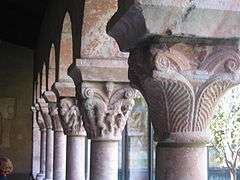
The Cuxa Cloisters are located on the south side of the building and structurally and thematically are the museum's centerpiece.[30] They are from the Benedictine monastery of Saint-Michel-de-Cuxa, Mount Canigou in the northeast French Pyrenees, founded in 878.[31] The monastery was abandoned in 1791. Around half of the building was relocated to New York, after it was purchased by Barnard in 1906 and 1907.[31][32] Until then it had been in disrepair; its roof had collapsed in 1835, followed by its bell tower in 1839.[33] They were then acquired by John D. Rockefeller Jr in 1925, and their installation was one of the first major undertakings by the Metropolitan after it had acquired and absorbed his Barnard's collection. After intensive work over fall and winter 1925–26, the Cuxa cloister was finally opened to the public on April 1, 1926.[34][35]
The Cuxa cloisters are placed at the center of the museum; its quadrangle-shaped garden once formed a center around which monks slept in cells. Its original garden seemed to have lined walkways around adjoining arches lined with capitals enclosing the garth. The oldest plan of the original building describes lilies and roses.[36] It is impossible to now represent all medieval species and arrangements; those in the Cuxa are approximations by botanists specializing in medieval history.[36] At the center is an eight sided fountain situated at the intersection of the two walkways.[37]
The walls are modern, while the capitals and columns were cut from Languedoc marble, a pink stone from the Pyrenees.[34] They capitals were cut at different points in its history, and thus contain a variety forms and more abstract geometric patterns, including scrolling leaves, pine cones, sacred figures such as Christ, the Apostles, and angels, as well as monstrous creatures such as two headed animals, lions restrained by apes, hybrids, monstrous mouths consuming naked human torsos, and a mermaid.[38][39]
The motifs may be derive from popular fables,[31] represent the brute forces of nature or evil,[40] or based on late 11th and 12th century monastic writings, such as those by Bernard of Clairvaux (1090-1153).[41] The order in which the capitals were originally placed is unknown, making their interpretation especially difficult, although an overall sequential and continuous narrative was probably never intended.[42] According to art historian Thomas Dale, to the monks, the "human figures, beasts, and monsters" may have represented the "tension between the world and the cloister, the struggle to repress the natural inclinations of the body".[43]
Bonnefont
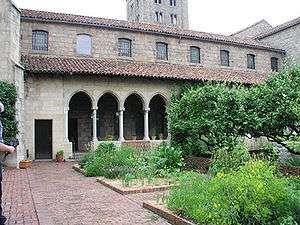
The four walkways of the Bonnefont cloisters surround a medieval herb garden. The Bonnefont cloisters are a composite from a number of monasteries from the region, in large part from a late 12th century Cistercian abbey at Bonnefont-en-Comminges, southwest of Toulouse in southern France.[44] The abbey was intact until at least 1807, when it was documented. By the 1850s, any of its architectural features had been removed, and could be found in the surrounding areas, decorating public and private buildings.[45] Today the clositers contain twenty-one double capitals, surrounding a garden that contains many typical features of the medieval period, including a wellhead, raised flower beds, and fences lined with acacia.[46] The marbles are highly ornate and decorate, some contain two registers, some with grotesque figures. The garden contains raised beds bordered by bricks and wattle fences.[47]
The garden contains a medlar tree found in The Hunt of the Unicorn tapestries, and is centered around a wellhead in use since the 12th century. The remnants of the Bonnefont cloisters were acquired by Barnard in 1937.[48]
Trie
The Trie cloister were originally part of a convent for Carmelite nuns at Trie-sur-Baïse, in south-western France. The original abbey, except for the church, was destroyed by Huguenots in 1571.[49] Like those from Saint-Guilhem, the Trie cloisters have been roofed.[50] A number of small and narrow buttresses were added to the exterior by the curator Joseph Breck, who based their design on features at Kenilworth Castle in Warwickshire, England.[51]
The convent originally contained 81 white marble capitals,[52] carved between 1484-1490.[53] Eighteen are now at The Cloisters, and contain numerous biblical scenes and incidents form the lives of saints. There is evidence of secularization in some of the carvings, with biblical scenes merged with characters from legend, including Saint George and the Dragon.[52] Examples include a "wild man" confronting a grotesque monster, and the droll head wearing a very unusual and fanciful hat.[52] The biblical capitals are placed in chronological order, beginning with God in the act of creation at the north west corner, Adam and Eve in the west gallery, followed by and Abraham sacrificing Isaac, and Matthew and John writing their gospels. Capitals in the south gallery illustrate scenes from the life of Christ, from the Annunciation to the Entombment.[54]
The Trie cloisters surround a rectangular garden which hosts around 80 species of plants, and contains a tall limestone waterfall at the center.[55] The waterfall is a composite of two late 15th- to early 16th-century French structures.[53]
Saint-Guilhem
The Saint-Guilhem cloisters originate from the site of the Benedictine monastery of Saint-Guilhem-le-Désert. Some elements date to 804,[29] with other pieces from the 1660s. Around 140 architectural elements were transferred to New York. They were one of Barnard's early acquisitions, from 1906.[56] At the time, the site marked an important stopping point in the pilgrimage route to Santiago de Compostela in northwestern Spain.[57]
The unusual and innovative carvings on the marble piers and column shafts are in places coiled by extravagant foliage, including vines, and recall Roman sculpture.[58] The capitals contain acanthus leaves and grotesque heads peering out,[59] including representations of the Presentation at the Temple, Daniel in the Lions' Den,[60] and the Mouth of Hell,[61] and a number of pilasters and columns.[29] The carvings seem preoccupied with the evils of hell. Those beside the mouth of hell contain the head of the devil, and nearby are various tormenting beasts with, according to art historian Bonnie Young, "animal-like body parts and cloven hoofs [as they] herd naked sinners in chains to be thrown into an upturned monster's mouth".[62]
The Saint-Guilhem cloisters is located in an indoor section of the building, and is small than its original incarnation.[63] It covered by a skylight and plate glass panels which conserves heat in the winter months. Its plant are mostly potted or in containers, including a 15th-century glazed earthenware vase. The small garden contains a central fountain.[64]
Gardens
The Cloisters is fortified, as would have been the original churches and abbeys. During times of invasion, well developed and productive gardens would have been essential for survival.[65] Today the gardens of the Cloisters contain a wide variety of mostly rare medieval species,[66] amounting to over 250 genera of plants, flowers, herbs and trees, making it one of the world's most important collection of specialized gardens. Their design was overseen by during the museums build by James Rorimer, aided by Margaret Freeman, who conducted extensive research into both the keeping of plants and their symbolism in the Middle Ages.[67]
Today the gardens are tended by a staff of horticulturalists; the senior members are also historians and researchers on medieval gardening techniques.[68]
Collection

The Cloisters contains approximately five thousand individual European medieval works of art, mostly from the 12th to 15th centuries. It holds several ivory c. 1300 Gothic Madonna ivory statuette, mostly French, with some English examples. Other major works include the Flemish tapestries The Hunt of the Unicorn (c. 1495-1505, probably woven in Brussels or Liège[69] the Nine Heroes tapestries, Robert Campin's c. 1425-28 Mérode Altarpiece panel painting,[70] and the 12th-century ivory Cloisters Cross.
The museum has an extensive collection of frescoes, stained glass, manuscripts, porcelain statuettes, reliquarys, wood sculptures and boxwood rosary beads. It further holds liturgical vessels, and rare pieces of Gothic furniture and metalwork.[71]
Illuminated manuscripts
The museum has collected four medieval illuminated books, each of the first rank and of major art historical interest. Their acquisition was a significant achievement for the museums early collectors - but consensus among the ruling hierarchy believed the Cloisters should focus on architecture rather than manuscripts, then considered more suited to the Pierpont Morgan Library.[72]
The four books are the c. 1330 French "Cloisters Apocalypse" (containing the Book of Revelations),[73] the "Hours of Jeanne d'Evreux" (1325–28), the Psalter of Bonne de Luxembourg and the Limbourg brothers' "Les Belles Heures du Duc de Berry" (1399–1416).
-

Hours of Jeanne d'Evreux, French, Jean Pucelle for Jeanne d'Evreux, 1325–28
-
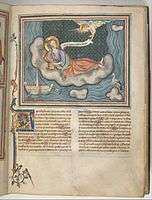
John on the Island of Patmos, folio 3 r. "The Cloisters Apocalypse", c. 1330
-

Miniature from the Belles Heures of Jean de France, Duc de Berry, French, 1399–1416
-

Psalter of Bonne de Luxembourg, Unknown, possibly Jean Le Noir or circle. French, 14th century
Stained glass
The Cloisters' collection of stained glass includes almost three hundred panels, mostly French and Germanic, and mostly from the 3rd to the early 16th century.[74] They are characterized by vivid colors and often abstract designs and patterns. Many are made from hand made opalescent glass.[75] Typical of the development of such art works, the collections's pot-metal works (ie containing colorants) from the High Gothic period highlight the effects of light,[74] especially interplay between darkness and illumination.[76] The collection grew from acquisitions in the early 20th century by Raymond Picairn, who was acquiring at a time when medieval glass was not a highly sought by connoisseurs. There were a number of reasons for this, including the fact that pieces were not easily extractable, and even then difficult to transport.[77]
Jane Hayward, a curator at the museum from 1969, believed stained glass was "unquestioningly the preeminent form of Gothic medieval monumental painting",[78] and began a second phase of acquisition.[78] She bought c. 1500 heraldic windows from the Rhineland, now installed in the Campin room with the Mérode Altarpiece, acquired in 1950. Hayward's 1980 addition lead to a redesign of the room so that the installed pieces would echo the domestic setting of the altarpiece. She wrote that the Campin room is the only gallery in the Met "where domestic rather than religious art predominates, [because] a conscious effort has been made to create fifteenth-century domestic interior similar to the one shown in [Campin]'s Annunciation panel."[79] Other acquisitions from this time include c. 1265 grisaille panels from the Château-de-Bouvreuil in Rouen, the Cathedral of Saint-Gervais-et-Saint-Protais at Sées,[79] and panels from the Acezat collection, now in the Heroes Tapestry Hall.[80]
-

Grisaille panel, Cathedral of Saint-Gervais-et-Saint-Protais, Sées, 1270–80
-

From the Church of St. Leonhard, Lavanttal, Austria
-

From the Schlosskapelle, Ebreichsdorf, Austria
- ^ Husband (2001), 35
Library and archives
The Cloisters Library is one of the Metropolitan Museum's thirteen libraries. It contains 15,000 volumes of books, its archive administration papers, the personal papers of Barnard, early glass lantern slides of museum materials, curatorial papers, museum dealer records, scholars records, recordings of musical performances at the museum and maps.[81]
Selected objects
-

The Virgin and Child in Majesty and the Adoration of the Maji. Romanesque fresco, Spanish, c. 1100
-
Doorway from the Church of San Leonardo al Frigido, Tuscany, Italy, c. 1175
-

The Cloisters Cross, English, 12th century
-

Enthroned Virgin and Child, English, c. 1300
-

The Crucified Christ, Northern European, c. 1300
-
.jpg)
Capital with beast, Saint-Guilhem Cloisters
-
.jpg)
La marche des âmes damnées, Saint-Guilhem Cloisters
-
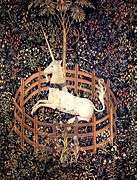
One of the Hunt of the Unicorn tapestries, Brussels or Liège. c 1495 - 1505
-
Porcelan statuette
-
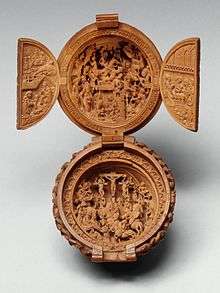
Rosary Bead, south Netherlandish, boxwood, 1500–1510
See also
- List of museums and cultural institutions in New York City
- List of New York City Landmarks
- National Register of Historic Places listings in New York County, New York
References
Notes
- ↑ Barnet (2005), 11
- ↑ By Germain Bazin, former curator in chief of the Louvre. See Tomkin (1970), 308
- ↑ Young (1979), 1
- 1 2 Parker (1992), 43
- 1 2 "The Cloisters in Popular Culture: "Time in This Place Does Not Obey an Order"". Metropolitan Museum of Art.
- ↑ Hayward (1992), 38
- ↑ New York City Landmarks Preservation Commission; Dolkart, Andrew S. (text); Postal, Matthew A. (text) (2009), Postal, Matthew A., ed., Guide to New York City Landmarks (4th ed.), New York: John Wiley & Sons, ISBN 978-0-470-28963-1, p.213
- ↑ "The Cloisters Museum and Gardens". The Metropolitan Museum of Art. Retrieved 15 May 2016
- ↑ Rorimer (1951), 267
- ↑ Young (1979), 14
- ↑ Young (1979), 23
- ↑ Young (1979), 17
- ↑ Wixom (1988–89), 36
- ↑ Forsyth, 38
- ↑ Forsyth, 33, 38
- ↑ Young (1979), 31
- 1 2 3 Barne (2005), 47
- ↑ Young (1979), 40
- ↑ "Chapel from Notre-Dame-du-Bourg at Langon . Metropolitan Museum of Art. Retrieved 14 May 2016
- 1 2 Young (1979), 76
- 1 2 Young (1979), 80
- 1 2 3 Young (1979), 82
- ↑ Young (1979), 80–84
- ↑ "Tomb Effigy of a Lady". Metropolitan Museum of Art. Retrieved June 5, 2016
- ↑ Brown, 409
- 1 2 Siple, 88
- 1 2 Young (1979), 6
- ↑ Barnet, 78
- 1 2 3 Barnet, 58
- ↑ Husband (2013), 33
- 1 2 3 "Cuxa Cloister". Metropolitan Museum of Art. Retrieved May 15, 2016
- ↑ Dale (2001), 405
- ↑ Young (1979), 47
- 1 2 Husband (2013), 22
- ↑ "The Opening of the Cloisters". The Metropolitan Museum of Art Bulletin, Volume 21, No. 5, 1926. 113-116
- 1 2 Bayard, 37–42
- ↑ Peck (1996), 31
- ↑ Dale (2001), 407
- ↑ Horste (1982), 126
- ↑ Calkins (2005), 112
- ↑ Dale (2001), 402
- ↑ Dale (2001), 406
- ↑ Dale (2001), 410
- ↑ Rorimer (1972), 20
- ↑ Young (1979), 93
- ↑ McGowan, Sarah. "The Bonnefont Cloister Herb Garden". Fordham University. Retrieved May 22, 2016
- ↑ "Bonnefont Cloister". Metropolitan Museum of Art. Retrieved 15 May 2016
- ↑ Young (1979), 98
- ↑ Husband (2013), 10
- ↑ Husband (2013), 34
- ↑ Husband (2013), 38
- 1 2 3 Young (1979), 96
- 1 2 Rorimer (1972), 22
- ↑ Young (1979), 97-9
- ↑ Barnet (2005), 18
- ↑ Husband (2013), 8
- ↑ Rorimer (1972), 17
- ↑ Parker (1992), 10
- ↑ Yarrow, Andrew. "A Date With Serenity At the Cloisters". New York Times, 13 June 1986. Retrieved 21 May 2016
- ↑ "Saint-Guilhem Cloister". Metropolitan Museum of Art. Retrieved 15 May 2016
- ↑ Young (1979), 24-25
- ↑ Young (1979), 26
- ↑ Young (1979), 23
- ↑ Bayard, 81
- ↑ Baynard (1985), 1
- ↑ Baynard (1985), vii
- ↑ Baynard (1985), 1-2
- ↑ Baynard (1985), 2
- ↑ "Gallery 017 – Unicorn Tapestry Hall (The Cloisters)". The Metropolitan Museum of Art.
- ↑ For example by Lorne Campbell in The Fifteenth Century Netherlandish Paintings, National Gallery Catalogues, 72, l, 1998, ISBN 1-85709-171-X and his 1974 Burlington article JSTOR specifically dealing with the authorship of the work
- ↑ Rorimer (1948), 237
- ↑ Deuchler (1971), 1
- ↑ Deuchler (1969), 146
- 1 2 Husband (2001), 33
- ↑ Hayward (1992), 36
- ↑ Cotter, Holland. "Luminous Canterbury Pilgrims: Stained Glass at the Cloisters". New York Times, February 27, 2014. Retrieved June 2016
- ↑ Hayworth (1992), 45
- 1 2 Clarke (2004), 31
- 1 2 Clarke (2004), 32
- ↑ Hayworth (1992), 303
- ↑ "The Cloisters Library and Archives". Metropolitan Museum of Art. Retrieved 15 May 2016
Sources
- Barnet, Peter. The Cloisters: Medieval Art and Architecture. CT: Yale University Press, 2005. ISBN 978-1-5883-9176-6
- Bayard, Tania. Medieval Gardens and the Gardens of the Cloisters. Metropolitan Museum of Art, 1985
- Calkins, Robert. Monuments of Medieval Art. Cornell University Press, 2005. ISBN 978-0-8014-9306-5
- Clark, John. English and French Medieval Stained Glass in the Collection of the Metropolitan Museum of Art. New York: Harvey Miller Publishers, 2003. ISBN 978-1-8725-0137-6
- Dale, Thomas E. A. "Monsters, Corporeal Deformities, and Phantasms in the Cloister of St-Michel-de-Cuxa". The Art Bulletin, volume 83, no. 3, September, 2001
- Deuchler, Florens; Hoffeld, Jeffrey; Nickel, Helmut. "The Cloisters Apocalypse: An Early Fourteenth-Century Manuscript in Facsimile". New York: Metropolitan Museum of Art, 1971
- Deuchler, Florens. "The Cloisters: A New Center for Mediaeval Studies". The Connoisseur 172, November 1969
- Forstyh, William. A Gothic Doorway from Moutiers-Saint-Jean. New York: Metropolitan Museum of Art, 1979
- Hayward, Jane. "Two Grisaille Glass Panels from Saint-Denis at The Cloisters". In Parker, Elizabeth. The Cloisters: Studies in Honor of the Fiftieth Anniversary. New York: Metropolitan Museum of Art, 1992. ISBN 978-0-8709-9635-1
- Horste, Kathryn. "Romanesque Sculpture in American Collections". Gesta 21, no. 2, 1982
- Hoving, Thomas. King of the Confessors. New York: Simon & Schuster, 1981
- Husband, Timothy. "Creating the Cloisters". The Metropolitan Museum of Art Bulletin, volume 70, no. 4, Spring, 2013
- Husband, Timothy. "Medieval Art and the Cloisters". The Metropolitan Museum of Art Bulletin, Volume 59, No. 1, "In: Ars Vitraria: Glass in the Metropolitan Museum of Art", 2001
- Parker, Elizabeth. The Cloisters: Studies in Honor of the Fiftieth Anniversary. New York: Metropolitan Museum of Art, 1992. ISBN 978-0-8709-9635-1
- Peck, Amelia (ed). Period Rooms in the Metropolitan Museum of Art. New York: Metropolitan Museum of Art, 1996. ISBN 978-0-8709-9805-8
- Reynolds Brown, Katharine. "Six Gothic Brooches at The Cloisters". In Parker, Elizabeth. The Cloisters: Studies in Honor of the Fiftieth Anniversary. New York: Metropolitan Museum of Art, 1992. ISBN 978-0-8709-9635-1
- Rorimer, James J. Medieval Monuments at the Cloisters. New York: Metropolitan Museum of Art, 1972. ISBN 978-0-8709-9027-4
- Rorimer, James J. The Cloisters. The Building and the Collection of Mediaeval Art in Fort Tryon Park, 11th edition, New York 1951
- Rorimer, James J. "A Treasury at the Cloisters". The Metropolitan Museum of Art Bulletin, Volume 6, No. 9, 1948
- Siple, Ella. "Medieval Art at the New Cloisters and Elsewhere". The Burlington Magazine for Connoisseurs, Volume 73, No. 425, 1938
- Tomkins, Calvin. "The Cloisters ... The Cloisters ... The Cloisters". The Metropolitan Museum of Art Bulletin, Volume 28, No. 7, 1970
- Uzig, Nicholas M. "(Re)casting the Past: The Cloisters and Medievalism". The Year's Work in Medievalism, Georgia Institute of Technology, 2012
- Wixom, William. "Medieval Sculpture at The Cloisters". The Metropolitan Museum of Art Bulletin, volume 46, no. 3, Winter, 1988–1989.
- Young, Bonnie. A Walk Through The Cloisters. New York: Viking Press, 1979. ISBN 978-0-8709-9203-2
External links
| Wikimedia Commons has media related to The Cloisters. |
- "Visit The Cloisters". The Metropolitan Museum of Art.
- "Medieval Art and The Cloisters". The Metropolitan Museum of Art.
- Cloisters Archives Collection from the Digital Collections from The Metropolitan Museum of Art Libraries
- The Cloisters' 75th Anniversary Samantha Dossena, L'Idea Magazine N.4, 2013


